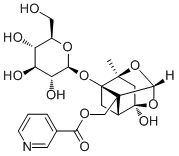PyridylpaeoniflorinCAS# 1427054-19-0 |

Quality Control & MSDS
Package In Stock
Number of papers citing our products

| Cas No. | 1427054-19-0 | SDF | Download SDF |
| PubChem ID | N/A | Appearance | Powder |
| Formula | C22H27NO11 | M.Wt | 481.5 |
| Type of Compound | Other Terpenoid | Storage | Desiccate at -20°C |
| Solubility | Soluble in Chloroform,Dichloromethane,Ethyl Acetate,DMSO,Acetone,etc. | ||
| General tips | For obtaining a higher solubility , please warm the tube at 37 ℃ and shake it in the ultrasonic bath for a while.Stock solution can be stored below -20℃ for several months. We recommend that you prepare and use the solution on the same day. However, if the test schedule requires, the stock solutions can be prepared in advance, and the stock solution must be sealed and stored below -20℃. In general, the stock solution can be kept for several months. Before use, we recommend that you leave the vial at room temperature for at least an hour before opening it. |
||
| About Packaging | 1. The packaging of the product may be reversed during transportation, cause the high purity compounds to adhere to the neck or cap of the vial.Take the vail out of its packaging and shake gently until the compounds fall to the bottom of the vial. 2. For liquid products, please centrifuge at 500xg to gather the liquid to the bottom of the vial. 3. Try to avoid loss or contamination during the experiment. |
||
| Shipping Condition | Packaging according to customer requirements(5mg, 10mg, 20mg and more). Ship via FedEx, DHL, UPS, EMS or other couriers with RT, or blue ice upon request. | ||

Pyridylpaeoniflorin Dilution Calculator

Pyridylpaeoniflorin Molarity Calculator
| 1 mg | 5 mg | 10 mg | 20 mg | 25 mg | |
| 1 mM | 2.0768 mL | 10.3842 mL | 20.7684 mL | 41.5369 mL | 51.9211 mL |
| 5 mM | 0.4154 mL | 2.0768 mL | 4.1537 mL | 8.3074 mL | 10.3842 mL |
| 10 mM | 0.2077 mL | 1.0384 mL | 2.0768 mL | 4.1537 mL | 5.1921 mL |
| 50 mM | 0.0415 mL | 0.2077 mL | 0.4154 mL | 0.8307 mL | 1.0384 mL |
| 100 mM | 0.0208 mL | 0.1038 mL | 0.2077 mL | 0.4154 mL | 0.5192 mL |
| * Note: If you are in the process of experiment, it's necessary to make the dilution ratios of the samples. The dilution data above is only for reference. Normally, it's can get a better solubility within lower of Concentrations. | |||||

Calcutta University

University of Minnesota

University of Maryland School of Medicine

University of Illinois at Chicago

The Ohio State University

University of Zurich

Harvard University

Colorado State University

Auburn University

Yale University

Worcester Polytechnic Institute

Washington State University

Stanford University

University of Leipzig

Universidade da Beira Interior

The Institute of Cancer Research

Heidelberg University

University of Amsterdam

University of Auckland

TsingHua University

The University of Michigan

Miami University

DRURY University

Jilin University

Fudan University

Wuhan University

Sun Yat-sen University

Universite de Paris

Deemed University

Auckland University

The University of Tokyo

Korea University
- Malaysianol D
Catalog No.:BCX0245
CAS No.:1646330-59-7
- Bisacurone A
Catalog No.:BCX0244
CAS No.:127214-84-0
- ar-Turmerol
Catalog No.:BCX0243
CAS No.:1178899-16-5
- (S,E)-2-Methyl-6-(p-tolyl)hept-3-en-2-ol
Catalog No.:BCX0242
CAS No.:18383-55-6
- Creticoside A
Catalog No.:BCX0241
CAS No.:34336-00-0
- Kaempferol 3-O-neohesperidoside 7-O-glucoside
Catalog No.:BCX0240
CAS No.:78527-48-7
- Pteroside B
Catalog No.:BCX0239
CAS No.:29774-74-1
- 1-O-β-D-Glucopyranosylpaeonisuffrone
Catalog No.:BCX0238
CAS No.:1003888-20-7
- Mckeanianone B
Catalog No.:BCX0237
CAS No.:2035475-14-8
- Ciwujianoside C2
Catalog No.:BCX0236
CAS No.:114892-56-7
- Aristolodione
Catalog No.:BCX0235
CAS No.:109771-09-7
- Turmeronol B
Catalog No.:BCX0234
CAS No.:131651-38-2
- Pterosin L 2'-O-glucoside
Catalog No.:BCX0247
CAS No.:61102-11-2
- (2R,3S)-Pteroside C
Catalog No.:BCX0248
CAS No.:68399-16-6
- (2S,3S)-Pteroside C
Catalog No.:BCX0249
CAS No.:98855-62-0
- Dehydrozingerone
Catalog No.:BCX0250
CAS No.:1080-12-2
- Kaempferol 3-O-(2''-O-glucosyl)rutinoside
Catalog No.:BCX0251
CAS No.:55696-58-7
- Sanggenon B
Catalog No.:BCX0252
CAS No.:81381-67-1
- Chasmanthin
Catalog No.:BCX0253
CAS No.:20379-19-5
- Dulcisxanthone B
Catalog No.:BCX0254
CAS No.:869669-62-5
- (E)-4-(4-Hydroxyphenyl)but-3-en-2-one
Catalog No.:BCX0255
CAS No.:22214-30-8
- (E)-α-Atlantone
Catalog No.:BCX0256
CAS No.:26294-59-7
- Arucadiol
Catalog No.:BCX0257
CAS No.:105037-85-2
- Suffruticosol B
Catalog No.:BCX0258
CAS No.:220936-87-8
Determination of chemical variability of phenolic and monoterpene glycosides in the seeds of Paeonia species using HPLC and profiling analysis.[Pubmed:23497864]
Food Chem. 2013 Jun 15;138(4):2108-14.
A rapid, sensitive, and accurate HPLC-DAD method was developed and validated for simultaneous determination of one phenolic glycoside and seven monoterpene glycosides, including 1-O-beta-d-(4-hydroxybenzoyl)glucose (1), Pyridylpaeoniflorin (2), (8R)-piperitone-4-en-9-O-beta-d-glucopyranoside (3), oxypaeoniflorin (4), 6'-O-beta-glucopyranosylalbiflorin (5), albiflorin (6), beta-gentiobiosylpaeoniflorin (7), and paeoniflorin (8), in 44 batches of peony seeds from nine Paeonia species collected from different areas. Using the optimised method, separations were conducted with a YMC-pack ODS-A column with water/formic acid and methanol as the mobile phase. All eight analytes demonstrated good linearity (r(2)>0.9993). The recoveries, measured at three concentration levels, varied from 98.20% to 103.81%. Six compounds including 1 and 4-8 occur ubiquitously in all the seeds of nine Paeonia species, and compounds 2 and 3 showed undetectable levels or very low content in several samples. The seed samples were classified into several groups, which coincide with the taxonomy of Paeonia at the section level. Peony seed might be a useful resource in developing new herbal or food products.


